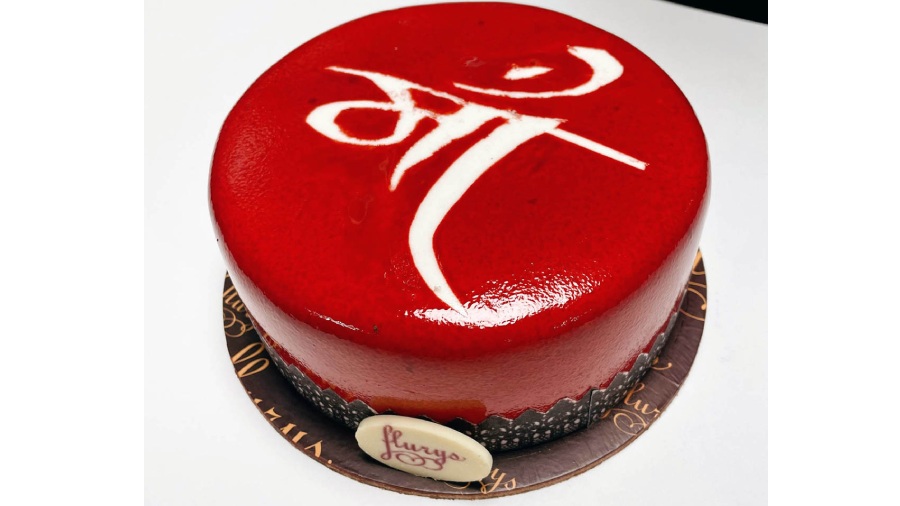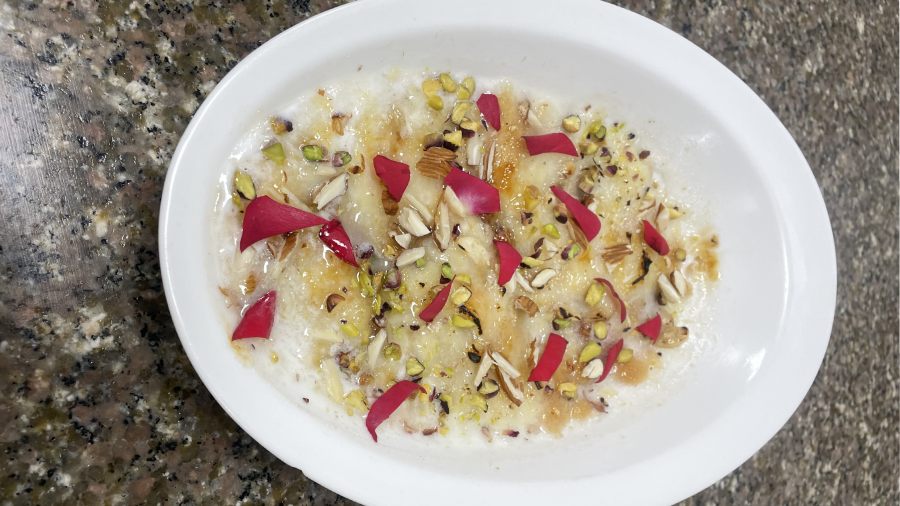Many rears back, I was visiting Egypt as a tourist and was sitting in a not-so-fancy restaurant in downtown Cairo. After having a below-average, dollar-priced meal of heavily-customised-to-Western-tastes Arabic delicacies, I was surprised by the heavenly dessert that followed. The dessert, somewhere in between a very flaky bread pudding and an Arabic fragrance-infused rich custard, was just what can provide culinary propulsion to an otherwise mediocre meal, and so it did.
For the same reasons, I have always believed that desserts should be served at the beginning of meals, as practised in many regional cultures of India as well as being prescribed in Ayurveda, although for health reasons.
On asking the young Egyptian chef about the dessert, he said something quite riveting and rather emotive. With a wide grin, the chef, whose name was incidentally also Ali, said that the hugely popular, traditional dessert was called ‘Uhm Ali’, which literally meant ‘Ali’s mother’. He said, “Habibi, see, a food dish with ‘mother’ in its name itself has to be very delicious!”
Although it was somewhat rhetorical I thought, but it does make sense. We generally associate our fondest food memories with our mothers or other women of the house and even the best chefs in the world return to their mother’s food for comfort and inspiration. Although I myself belong to a very simple-eating vegetarian household, it is true that I also crave for my mother’s food most of the meal periods and would gladly trade the fanciest ravioli caprese for her unostentatious rajma chawal.
While on the topic, the other day, I was rather haughtily boasting to a group of friends about how I might be among the very few present there that went to a physical office and ‘worked’ every day of all the lockdowns during the previous years and was sharing the unusual experiences I had had during those uncertain times.
My elder daughter, pretending all this while not to overhear us, enounced rather sharply and loudly saying “Hey Dad, you know who else went to work each day of the lockdown? All the moms!” While I have gotten somewhat used to the smart quips of a teenager in the last couple of years, this statement from her made me to think a bit.
We don’t really give enough credit to our moms for all that they do for us — while we say we do in our deepest subconscious. As a society, we always take for granted what women actually do selflessly around our homes, especially the working moms. To that extent indeed, every day is Mother’s Day in its truest sense, and while it is a good thing to celebrate a day in the honour of our moms, it is doubtless to say that the mom is indeed underrated and under-celebrated, but she is absolutely the everyday superstar.
Mom and food
So the question that begs to be asked is whether, in reality, mother’s food is the best, or other factors make us perceive it as the best. There are multiple pieces of research done on the topic and according to one research conducted by Christy Fergusson, a UK-based food psychologist, the food that is perceived to have been ‘made with love’ tastes more delicious.
It is believed that the emotional perception of taste can be enhanced or diminished by the amount of time, love and care that goes into making those meals. This can result in increasing people’s enjoyment of food. Many of us chefs also endeavour to put a lot of personal effort into cooking and while love is a specific emotion, we do indeed see that the food is cooked with passion, care and restraint, the elements that we hope make our food taste better and special.
According to research led by Bird’s Eye, a global frozen food retailer, it was concluded that an overwhelmingly large number of people enjoyed their food which was shown to have been made with more love and care than the same food being dished out without much of an emotional connect.
Studies seem to suggest that there is a lot more going into our foods when our mothers cook them than mere ingredients and application of heat. There is the warmth of love as well as the gentleness and care that go into cooking for someone you truly care about have a lot of say in how these dishes taste.
Historical contexts
Throughout history, women have been the forerunners in providing ready meals to the entire household, while men were traditionally seen as working for the food and fending for the family. While the act of eating is a highly social activity, the cultural rituals of preparing, serving and cleaning up after meals have largely been the domain of the woman of the house, typically the mother.
Back in the day, food preparation, especially for large families, used to be a day-long process that required hard work, planning and denial of self gratifications. In my village home, I have myself seen the women of large joint families spend the major part of their day just cooking. Apart from cooking, women of the house are also major contributors to the production of raw food, although this enterprise of theirs does not receive the same levels of recognition as those of their male counterparts.
According to a report by USAID, women are responsible for half of the world’s food production and in most developing countries they produce as much as 60 per cent to 80 per cent of the food. Although the current urban trend and availability of easy-to-cook pre-made foods, mushrooming of fast-food restaurants and the upswing of home deliveries have made it convenient, if not affordable to a whole lot of mothers who can now plan their lives around these if need be.
An interesting phenomenon in this segment is also the runaway popularity of ‘home-cooked’ meals that leverage the ‘mom-cooked’ emotion and are hugely popular as delivery options, especially for the young, single office goers and sometimes for the outstation college students.
Mother’s Day today
Celebrating motherhood or mother herself has been known to be observed for past hundreds of years, starting in the Middle Ages when ‘Mothering Sunday’ was observed on the fourth Sunday of Lent, known as “Laetare Sunday” by those who had moved away from their parishes.
In its modern format, the way it is celebrated is as a significant observance on the second Sunday of May every year, especially across the US and Europe and now increasingly across the world. It is believed to have started from May 12, 1907, by Anna Jarvis of Philadelphia, US. She is said to have conducted a memorial service in the memory of her late mother at her church in Grafton, West Virginia, US, and within five years virtually all states in the US and many countries across Europe were also observing the commemoration.
Mother’s Day was made a National Holiday in the US in 1914 by its then president Woodrow Wilson. While the custom developed throughout the world, it was ironic that the same Anna Jarvis spent the last years of her life trying to abolish the holiday of Mother’s Day, opposing the blatant commercialisation that came with it.
In India, the trend of celebrating Mother’s Day has caught up very fast in the last decade or so, especially in the larger cities. Most restaurants, hotels, bars and cafes conduct special promotional campaigns to celebrate Mother’s Day. While many come up with special menu items, some others gratify the mothers in their own ways through promotions or complimentary food and drinks.

We, at Flurys, have been observing Mother’s Day promotions for the last many years and come out with special cakes and goodies each year. We make it a point to design our cakes and menus amalgamating the Indian values and I strongly believe that we in India have traditionally connected to our mothers in a much more emotional, even spiritual way than the rest of the world.
For the recipe for this special column, I have selected something truly special, the Egyptian dessert ‘Uhm Ali’ that I discussed at the beginning of this write-up (see Ali’s Uhm Ali). Ali, the chef, was very kind to share with me the recipe, which was an heirloom recipe of his mother and was quite proud in doing so.
The unpretentious but delicious and delicate dessert, Uhm Ali is kind of like a bread pudding but made with laminated pastry and reduced milk. In many ways, the flavours resemble a lot of Indian dessert flavours and one can identify them with some of the mithais popular in India.
I do hope you enjoy this fragrant, simple but luscious dessert with your mom and if you were really to take my advice, serve this to her at the beginning of the meal and see her eyes light up; tell her she’s your world.
Vikas Kumar is the director food production of Flurys. You can reach him at vkumar@flurys.com

Ali’s uhm ali
Ingredients
•Plain butter croissants: 6
•Milk: 1litre
•Condensed milk: 400g
•Mixed nuts (pistachio, cashew nuts, pine nuts, apricots, etc.): 50g
•Rosewater: 10ml
•Dried rose petals: 1tsp
•Whipped cream: 100ml
Method
Slice the croissants thin.
Boil the condensed milk and milk together until thick and add the rosewater.
Soak the sliced croissants in the hot milk for 30 minutes. Sprinkle the nuts and spread the whipped cream on top.
Bake in a hot oven at 200°C for 15-20 minutes till golden on top.
Serve warm, garnished with chopped fried nuts, rose petals and a sprinkle of rosewater.






